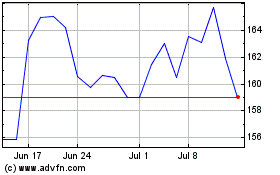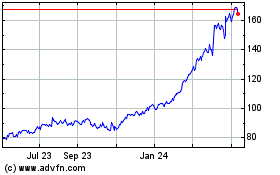By Ted Mann and Ryan Tracy
General Electric Co.'s lending arm became the first big
financial institution to escape stricter postcrisis rules by
dramatically shrinking its business, a strategic pivot in sync with
regulators' demands for firms to reduce risk-taking.
GE has chopped away at its financial business since last April,
when the company announced it was moving away from an operation
that once had more than $660 billion in assets -- underwriting
everything from credit cards to oil rigs -- and generated as much
as half of GE's annual profit.
Because GE had shrunk and restructured the business, the U.S.
Financial Stability Oversight Council said Wednesday it had voted
to remove GE's designation as a "systemically important" financial
institution, a label that had required the company to submit to
stricter rules and supervision by the Federal Reserve. The decision
frees up the manufacturer to borrow up to $20 billion for further
stock buybacks, GE executives have said.
Since deciding to wind down the finance arm, GE Capital has
signed agreements for the sale of about $180 billion of businesses
and has closed about $156 billion of those transactions. The head
of GE Capital, Keith Sherin, said the FSOC's decision is a result
of the transformation of GE Capital into a "smaller, safer
financial-services company."
GE's case marks the first time the oversight council has removed
a "systemically important" designation since the tag was created
under the 2010 Dodd-Frank financial overhaul law. For the oversight
council, the change is a significant response to critics who have
said its process for labeling firms as "systemically important" is
opaque and doesn't give firms a clear road map on how to reduce
risk.
"It proves something that we have believed for a long time: that
this is an analytic process; that it fact driven; and if a firm
changes its business line and its profile, there's [an] exit path
from the designation," Treasury Secretary Jacob Lew said in an
interview.
It was an orderly process at a time when FSOC -- a committee
made up of senior U.S. regulators and officials -- is caught in the
middle of both legal and political battles challenging its
authority.
On the legal front, the council is appealing a federal judge's
ruling nullifying its decision to apply the SIFI label to MetLife
Inc. The stakes are seen as so high that the government case has
drawn supporting briefs from an all-star cast of
financial-crisis-era policy makers, including former Federal
Reserve Chairmen Ben Bernanke and Paul Volcker, and former
lawmakers Chris Dodd and Barney Frank.
On the political side, Republicans in Congress are pushing for
legislation that would replace Dodd-Frank, including provisions
that would scale back FSOC's authority to designate firms as
possessing risks that could endanger the entire financial system.
Wednesday's announcement leaves two other nonbank firms with the
SIFI label: Prudential Financial Inc. and American International
Group Inc.
While GE Capital has shown it is possible to convince regulators
to rescind the SIFI label, the specifics of its case don't
necessarily apply to others. For example, regulators liked that GE
decided to guarantee GE Capital's debt. Its restructuring also came
on a massive scale that may not be an option for insurers such as
Prudential or AIG, though activist investor Carl Icahn has
pressured AIG to explore a breakup.
"We're unique. We have a big industrial parent," GE Capital's
Mr. Sherin said Wednesday. "If you're only in financial services,
your decision is -- maybe to split up and go into pieces."
The FSOC vote clears the way for GE to borrow and spend like an
industrial company again, a potential boon to investors who have
cheered Chief Executive Jeff Immelt's decision to move back toward
the company's roots as a manufacturer of high-tech machines like
wind turbines, locomotives and medical scanners. Shares of GE
gained 2% to $30.55 on Wednesday.
It is a swift comedown for GE Capital, a business that grew to
be among the biggest lenders in the country. Even after the
financial crisis, and despite years of clamoring from investors who
wanted GE to reduce its exposure to financial risk, the company had
$500 billion in assets at the end of 2014.
Months later, though, sparked by declining returns from lending
and rising regulatory costs which Mr. Sherin estimated at $1
billion a year, the company launched Project Hubble -- its
top-secret plan to drastically shrink GE Capital. The goal was to
sell around $260 billion in total assets by the end of 2017, a mark
the company could beat by almost a year.
Overall, 90% of employees from businesses that were sold went
along to new jobs at the acquiring firms, Mr. Sherin said. GE has
shifted 1,000 GE Capital employees to other jobs in the company,
and is helping its regulatory and compliance staff find jobs
elsewhere in the industry, he said.
Even once it has shrunk GE Capital, major financial-services
operations will remain. The reconfigured operation will have less
than $200 billion in assets including cash. It is holding on to its
profitable business that leases aircraft and finances jet engine
purchases. It also will retain its energy finance unit and a unit
that will handle capital needs for the company's manufacturing
businesses.
Without the tough rules from federal banking regulators, GE will
have more leeway to add debt to its balance sheet, something Nelson
Peltz's Trian Fund Management LP called for when the activist
investor took a $2.5 billion stake in the conglomerate last year.
Executives have been waiting to get out from under Fed oversight to
explore such moves.
"We very may well decide to add additional leverage to the
company, and we talked about something like $20 billion of
potential capacity over time, which gives us a lot more flexibility
around how we think about M&A as well," Chief Financial Officer
Jeffrey Bornstein said last week.
Write to Ryan Tracy at ryan.tracy@wsj.com and Ted Mann at
ted.mann@wsj.com
(END) Dow Jones Newswires
June 29, 2016 19:26 ET (23:26 GMT)
Copyright (c) 2016 Dow Jones & Company, Inc.
GE Aerospace (NYSE:GE)
Historical Stock Chart
From Mar 2024 to Apr 2024

GE Aerospace (NYSE:GE)
Historical Stock Chart
From Apr 2023 to Apr 2024
